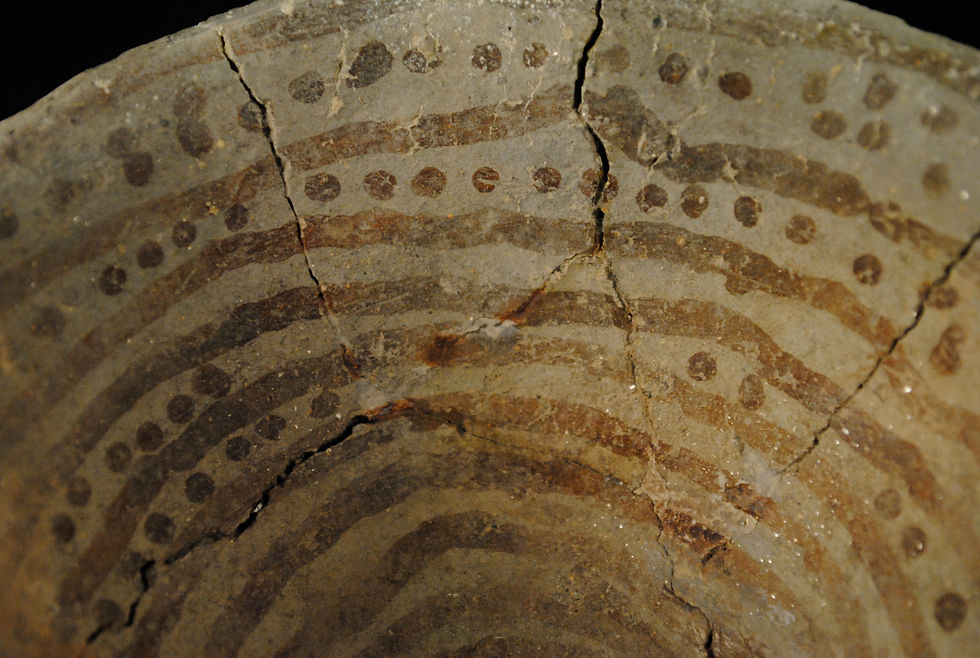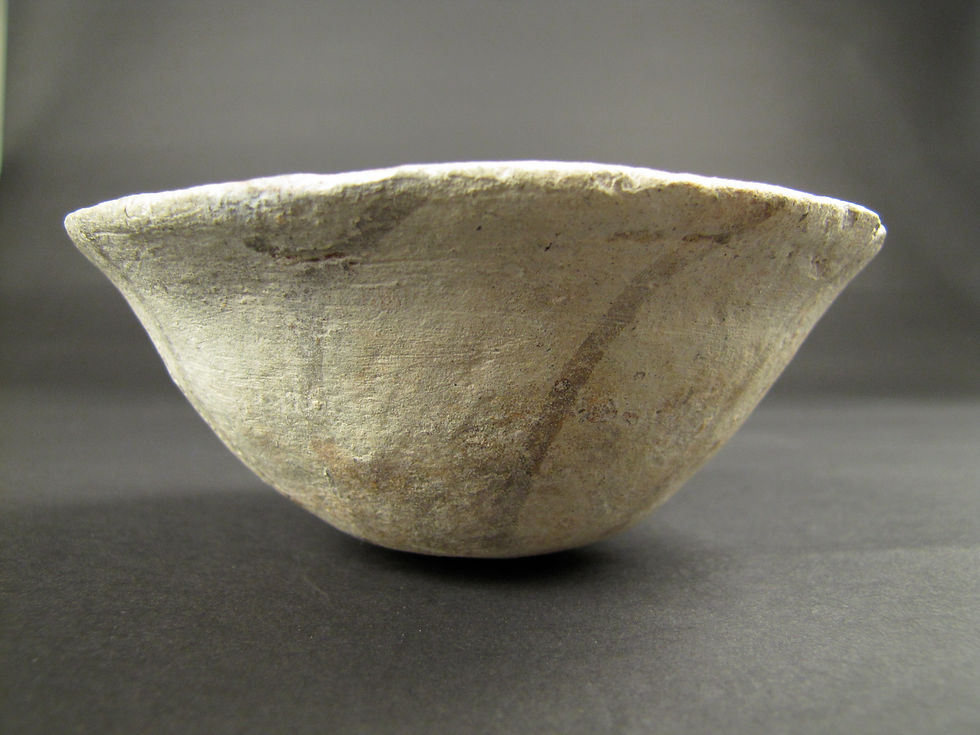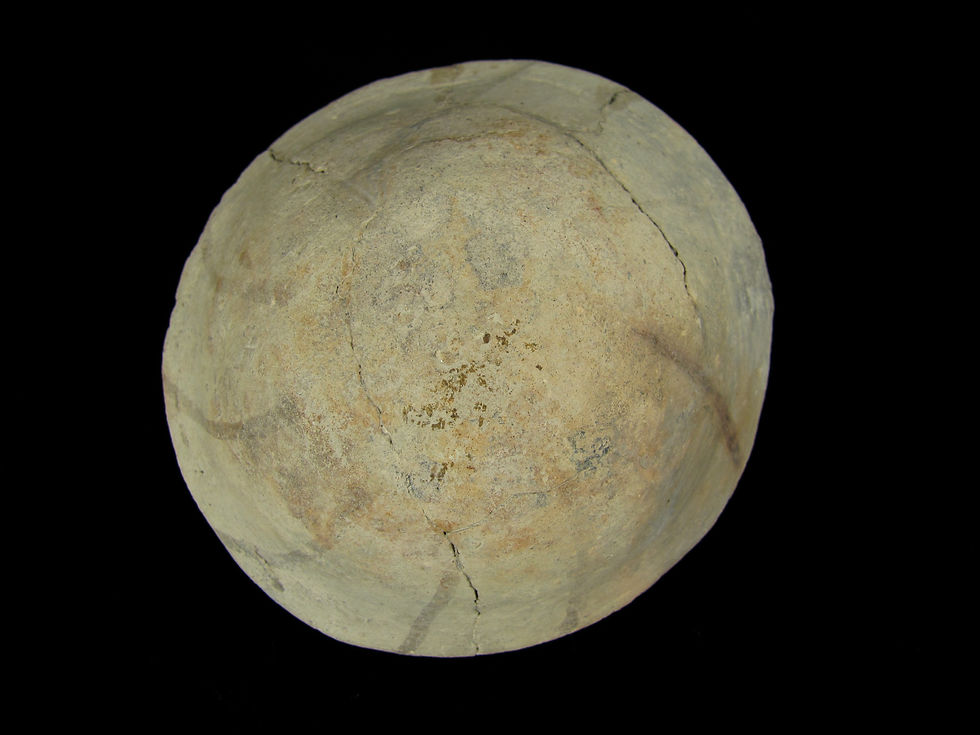The Jim and Vanita Oelschlager
Native American Ethnographic Collection

Small Bowl, ca. 700-900 CE Hohokam. Arizona. Clay, Pigment. 2” x 5.25” diameter The Salt River provided water for the native peoples in the Tucson Basin. The river supported the Hohokam’s elaborate canal networks with water for a thriving farming system where they grew corn, squash, many types of beans, and other vegetables.

Small Bowl, ca. 700-900 CE Hohokam. Arizona. Clay, Pigment. 2” x 5.25” diameter To supplement the crops, the Hohokam hunted game animals and gathered natural materials, such as pinion nuts.

Small Bowl, ca. 700-900 CE Hohokam. Arizona. Clay, Pigment. 2” x 5.25” diameter

Small Bowl, ca. 700-900 CE Hohokam. Arizona. Clay, Pigment. 2” x 5.25” diameter

Small Bowl, ca. 700-900 CE Hohokam. Arizona. Clay, Pigment. 2” x 5.25” diameter

Decorated Seed Jar, ca. 900-1100 CE Hohokam. Arizona. Clay, Pigment. 20” x 17” A stable food supply allowed the people to build larger villages and public gathering areas, such as large ceremonial mounds and ball courts. Grains and seeds were stored in large ollas or storage jars.

Decorated Seed Jar, ca. 900-1100 CE Hohokam. Arizona. Clay, Pigment. 20” x 17”

Decorated Seed Jar, ca. 900-1100 CE Hohokam. Arizona. Clay, Pigment. 20” x 17”

Decorated Seed Jar, ca. 900-1100 CE Hohokam. Arizona. Clay, Pigment. 20” x 17”
Modern Native Americans in Arizona and New Mexico say the ancients left their broken pottery lying around so that the generations to follow would know they had been there.
Two geographical and cultural areas represented by pottery in this exhibit are the Salt River drainage system near Phoenix, Arizona, and the Pueblo culture near Santa Fe, New Mexico.
The pots are a visual connection between the ancient peoples and their modern descendants. Both pottery traditions began by creating functional, utilitarian pieces, such as seed storage jars, water jugs, and figurines for ceremonial use. Although the ancients’ pottery was utilitarian, it was created in distinct styles with motifs and firing patterns that can be traced through the centuries to the pots created now by their modern descendants.
Archaeological sites yield remnants of objects and raw materials from other regions, indicating complex trade networks between widely scattered groups of people. The dry climate protected pottery from decomposition, thus archaeologists are able to trace migrations of people and pottery across centuries and regions.
The Salt River drainage area was the largest single body of land irrigated in prehistoric North America. Phoenix is located near the middle of that system. Archaeologists and modern Native Americans note that the complex Hohokam societies in this region built earthen mounds, adobe houses, and large canals for irrigation. Although evidence of corn cultivation appears around 2000 BCE, irrigation by about 1500 BCE, and sustained occupation of the region by 1200 BCE, archaeological evidence of the early ceramic period does not begin until about 200 CE. From about 450 CE to 1450 CE, the Hohokam culture and pottery dominated the region.
For 1000 years the Hohokam maintained a recognizable, fluid, and adaptable cultural tradition among diverse people who migrated into and around the Salt River region in the prehistoric Southwest. The Hohokam, “those who are all used up,” are the ancestors of modern Akimel O’odham and Tohono O’odham tribes. The Pueblo Grande Museum and Archaeological Park in Phoenix features a small section of an ancient Hohokam village and canal, and demonstrates the connections between ancient and Native American pottery of today.
Ancient Anasazi culture is ancestral for the second group in this exhibit. The “ancient ones” built the living centers that are now archaeological sites of Mesa Verde National Park (Colorado), Chaco Canyon National Historical Park (New Mexico), and Bandelier National Monument (New Mexico). These living areas were abandoned due to a long period of drought from about 1200 CE to 1500 CE. Their descendants settled in pueblo villages in the Rio Grande River Valley, and used small-scale irrigation for farming. Modern Pueblo Native Americans include the Hopi, and Pueblos of Zuni, Santa Clara, and others.
Both Hohokam and Anasazi pottery are the basis for long and living traditions. Twenty-first century artists use and adapt ancient designs, and artists tell their stories over ages, through migrations, drought, wars, and dramatic culture change.
When the Spanish arrived in the Southwest, they brought new tools and domestic animals and began to use pottery made by the resident population. From that time through Mexican independence from Spain (1821), the building of the Santa Fe Railroad (1820s), and United States’ annexation of the territory (1848), there was considerable demand for native-made objects, especially pottery and rugs.